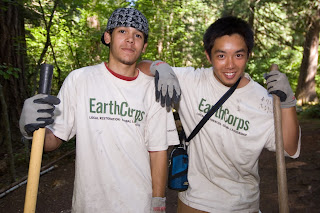Happy Friday everyone!
I’ve got lots to share on the blog today so let’s jump right in. I realized earlier in the week that I only have two months left of my season with the North Coast and Cascades Research Learning Network. Where has this summer gone? With all the projects I’ve become involved with, these next eight weeks will require some good time management skills in order to have actual completed projects. I now have 8 post-it notes on my desk with the priorities listed for the remaining weeks.
Post-it number one, as recommended by Sara Melena: NCCN graphic identity, specifically a logo, template for the Resource Briefs, and folder design.
The logo, as mentioned last week, is one of the hardest things to design. It has to be simple and iconic, yet represent an incredibly diverse and complex network. The logo should be specific to our region in terms of colors and content, yet also point back to the larger National Park System.
This was last week’s logo:

After many more brainstorms...

...I’ve eventually settled into this:

Now remember, nothing’s ever final, but this is my top choice and the one I’ll pitch to our Science Communication Committee. Thankfully, this group of 7 or so will make the final decision, not the entire network.

The logo represents the two main natural features of our network: mountains and water (the latter loosely includes coasts, rivers and lakes). The mountains rise up above the horizon as sharp angular shapes. The water ripples outwards in geometric curves. The green is taken from the color palette I developed last week: the dark, wet evergreen that covers every mountainside west of the Cascades. The green of the water is the same but as a 50% transparency.
If one examines the logo closely, eight shapes will be counted; 3 mountains and 5 water components. This is completely intentional as we have three large mountainous parks in our network—Mount Rainier, North Cascades and Olympic—and 5 smaller parks surrounded by or heavily influenced by water—Ebey’s Landing, Fort Vancouver, Klondike Gold Rush, Lewis and Clark and San Juan Island. 8 graphic elements, 8 network parks, all bound together by a surrounding circle.
The text, of course, ties it all together and I prefer the clean, sans-serif lines of our Frutiger 45 Light. I also felt fortunate that the words “The North Coast &” fit evenly above “Cascades Network” without any weird adjustment of spacing.
Chip Jenkins, NOCA’s superintendent, mentioned that the symmetry of the logo reminded him of Charley Harper’s work for the National Park Service.



I’d seen Harper’s posters before but hadn’t looked much further until this week. Have you ever found an artist, or author, or any other individual and immediately felt a connection to his/her work and ideas? I love the clean lines and reduction of complex subjects to “simple” shapes. I find that to be a more difficult, more witty exercise than to copy the subject individual feather by individual feather. As I read Harper’s biography and explored his body of work, I felt a mixture of relief that someone else had similar design aesthetics and anxiety that this person had already filled the creative niche.




Charley Harper died in 2007 and I feel sad that I hadn’t really discovered him before hand. I would have enjoyed seeing an exhibition, if not meeting him in person. Fortunately, he’s left behind
an incredible amount of work to provide me with inspiration. There’s this idea of one’s artwork always being part of a larger conversation with contemporary artists and all the artists that have lived before. I’d like to consider some of my work taking his ideas further in this dialogue. For example, he worked by hand and I work digitally. And I know how to animate my work...
Moving on from this art history critique…
Here is a re-design of the Resource Briefs that each monitoring team is supposed to update annually. I didn’t have to do too much, just some cleaning up to make it more readable and consistent with the overall graphic style we’ve developed.




Finally, here are some of the first drafts for a folder that would be used to hold network publications and products.


At first glance, it appears that it’s an abstract landscape, of mountain ranges expanding and fading into the background. Upon closer examination, one realizes the lines are part of graphs and that each peak or valley corresponds to one of the networks (listed on the bottom). If you fold out the back cover, the topics of the charts are revealed. Y-axis’ rise up at varying heights and intervals and text at the bottom explains what each graph measures: number of vital signs, total acreage, distance from Seattle, latitude and longitude, etc.
I’m still trying to figure out the best combination of colors and transparencies so that the resulting image hints at being both a landscape and graph, but without being overtly either.
Oh yeah, the light blue lines in the background should resemble a scientific ledger/notebook as well as rain showers. And this may be reading into the image too much, but does the y-axis lines remind anyone else of totem poles? Unintentional, but an appropriate reference to the cultural history of our region.
I’m also very open to suggestions of other things to graph (# of staff at each park? Annual rainfall?)
Well, I think this should be it for now. There’s a couple more things I could post, but this has turned into a very long entry, so I’ll table them for another time.
Have a wonderful weekend!





































